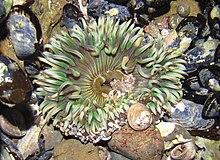Anthopleura elegantissima
| Aggregating anemone | |
|---|---|
 |
|
| Scientific classification | |
| Kingdom: | Animalia |
| Phylum: | Cnidaria |
| Class: | Anthozoa |
| Subclass: | Hexacorallia |
| Order: | Actiniaria |
| Suborder: | Nyantheae |
| Infraorder: | Thenaria |
| Family: | Actiniidae |
| Genus: | Anthopleura |
| Species: | A. elegantissima |
| Binomial name | |
|
Anthopleura elegantissima (Brandt, 1835) |
|
Anthopleura elegantissima, also known as the aggregating anemone or clonal anemone, is the most abundant species of sea anemone found on rocky, tide swept shores along the Pacific coast of North America. This cnidarian hosts endosymbiotic algae called zooxanthellae that contribute substantially to primary productivity in the intertidal zone.A. elegantissima has become a model organism for the study of temperate cnidarian-algal symbioses.
The polyps of Anthopleura elegantissima reach up to eight cm across the oral disk with approximately 100 tentacles in three or four rows around the margins of the oral disk. Most are olive to bright green (depending on the species of algal symbionts present) with tentacles tipped in pink. Individuals that live in microhabitats that are deficient in photosynthetically active radiation (PAR), such as under docks or in caves, lack symbionts and are pale yellow to white in color.
Pacific coast of North America from Alaska, United States to Baja California, Mexico.
This species of anemone is capable of reproducing both sexually and asexually. As adults, A. elegantissima release gametes into the water that join to form genetically unique individuals that settle on intertidal rock. This genetically distinct individual can then proliferate through binary fission. Some argue that this is not true reproduction but actually a form of growth. Fission is often prompted in the autumn by a decrease in the abundance of food and follows sexual spawning in summer. Over time, a single individual can generate a large colony of genetically identical polyps. Because of its ability to grow in this manner, the genetic entity of a colony is potentially immortal on an ecological time scale.
...
Wikipedia
